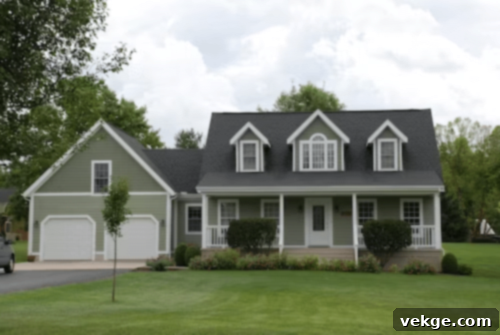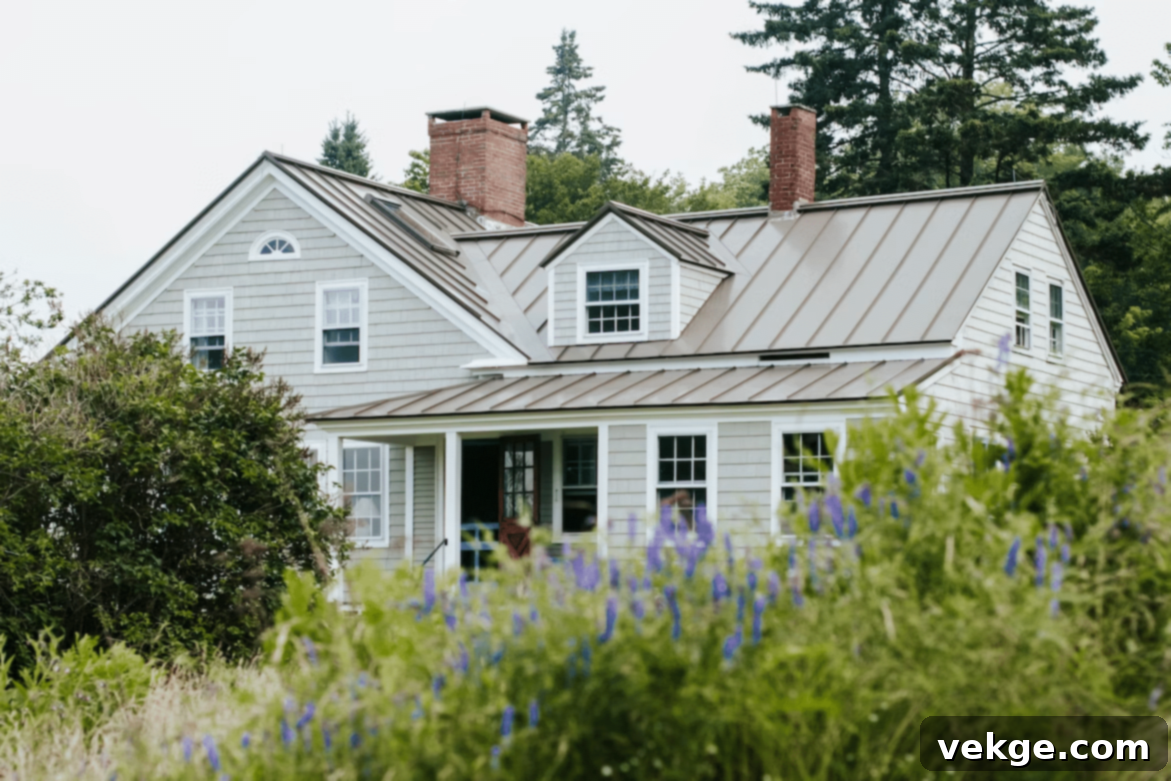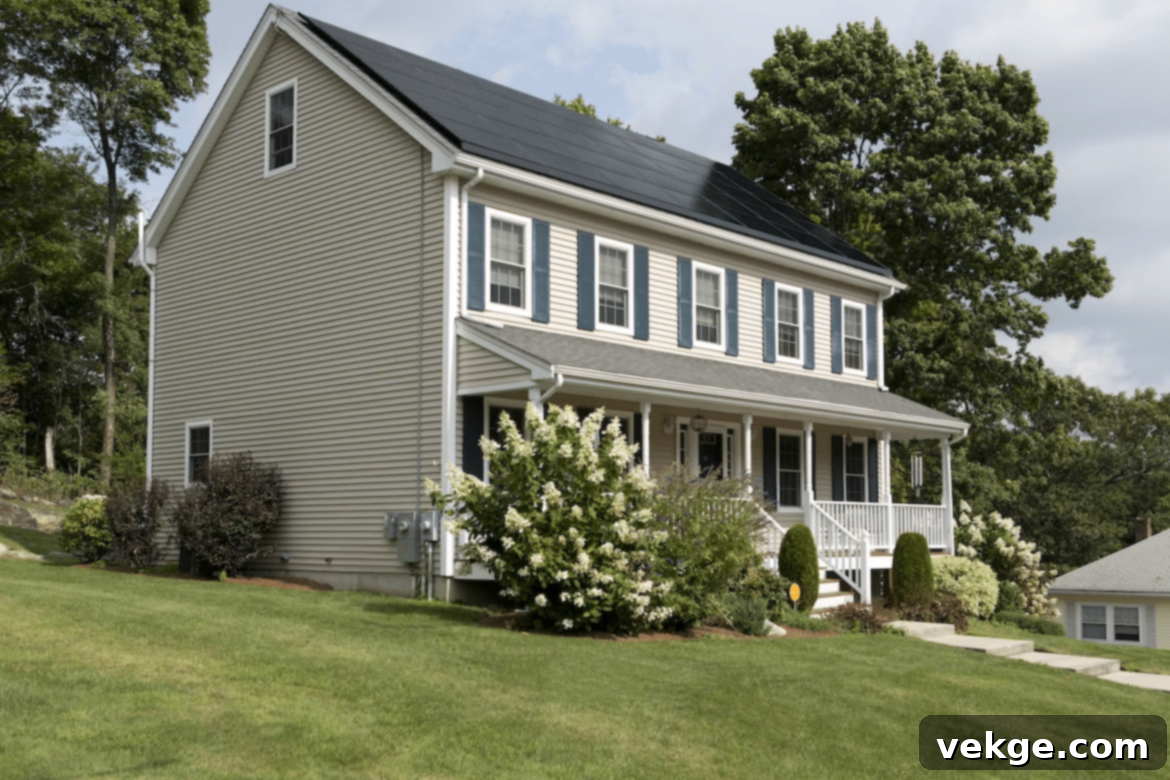Elevate Your Home’s Exterior: 5 Compelling Reasons to Choose Vinyl Siding for Lasting Value
Your home is more than just a structure; it’s a sanctuary, a canvas for your life’s precious moments, and a reflection of your personal style. It stands as a symbol of safety, comfort, and warmth, meticulously crafted to shelter you from the outside world. Crucial to this protection and aesthetic appeal is your home’s exterior, which serves as the first line of defense against the relentless elements and the passage of time. Among the myriad of materials available to clad your home, siding plays an indispensable role. While options range from traditional wood and brick to modern composites, vinyl siding consistently emerges as a leading contender, lauded for its unique blend of practical and aesthetic benefits. This versatile material has evolved significantly over the years, transforming into a sophisticated, durable, and attractive solution for contemporary homeowners. If you’re contemplating an exterior upgrade or building a new home, understanding your siding options is paramount. Join us as we delve into the world of vinyl siding, uncovering the five compelling reasons why this material should be at the top of your list for a resilient, beautiful, and cost-effective home exterior.
Vinyl Siding: A Comprehensive Overview
Imagine a protective, yet stylish, jacket for your home – that’s essentially what vinyl siding provides. Crafted primarily from polyvinyl chloride (PVC) resin, a highly durable and versatile plastic polymer, modern vinyl siding is engineered for exceptional performance. This isn’t the flimsy vinyl of yesteryear; today’s products boast advanced manufacturing techniques that enhance their rigidity, impact resistance, and aesthetic appeal. PVC is the same robust material often used in plumbing pipes and window frames, testifying to its inherent strength and long-lasting nature. When applied to your home’s exterior, vinyl siding forms a seamless barrier that not only significantly enhances curb appeal but also offers stalwart protection against the most challenging weather conditions, from torrential rain and heavy snow to blistering sun and strong winds. Its resilient composition makes it naturally resistant to common household threats like insect infestations, rot, and corrosion, which can plague other materials. Furthermore, vinyl siding is designed to retain its vibrant color without constant repainting or staining, thanks to UV-resistant additives and color formulations integrated directly into the material during production. This makes it an incredibly wallet-friendly choice, requiring minimal upkeep and translating into substantial savings on maintenance costs over its extensive lifespan. With an expansive array of colors, textures, and profiles, vinyl siding offers unparalleled design flexibility, allowing homeowners to perfectly match their home’s architectural style and personal taste, ensuring a distinctive and appealing finish.
5 Compelling Reasons to Consider Vinyl Siding Installation
The decision to install new siding is a significant investment in your home’s future, impacting its appearance, protection, and overall value. For many homeowners, vinyl siding stands out as an exceptionally smart choice, offering a host of advantages that address both practical needs and aesthetic desires. Let’s explore the key benefits that make vinyl siding a leading exterior solution.

Source: Unsplash
1. Unmatched Cost-Effectiveness and Long-Term Savings
For homeowners navigating budget considerations, vinyl siding emerges as a true champion of value. Its initial material and installation costs are remarkably lower compared to premium alternatives like wood, brick, or fiber cement siding. This immediate saving is a significant draw, allowing homeowners to undertake essential exterior upgrades without breaking the bank. However, the financial benefits of vinyl siding extend far beyond the initial purchase. The material’s inherent low-maintenance nature translates into substantial long-term savings on upkeep. Unlike wood, which demands regular painting, staining, sealing, and repairs due to rot or pest damage, vinyl siding requires virtually none of these costly and time-consuming interventions. You won’t need to factor in recurring expenses for paint, brushes, ladders, or the labor of professional painters every few years. This dramatically reduces the total cost of ownership over the lifespan of the siding. When evaluating a home improvement project, savvy homeowners consider the return on investment (ROI). Vinyl siding consistently offers a strong ROI, often recovering a significant portion of its installation cost upon resale due to its enhanced curb appeal and durable performance. In an economic climate where every penny counts, choosing vinyl siding is not just a purchase; it’s a shrewd financial decision that yields dividends for years to come.
2. Exceptional Durability and Extended Longevity
Your home is a legacy, and its exterior should be built to withstand the rigors of time and environment. Vinyl siding delivers on this promise with its exceptional durability and impressive longevity. This resilient material is engineered to resist a litany of common threats that often compromise other siding types. Unlike traditional wood siding, which is highly susceptible to termite infestations, carpenter ants, and wood-boring beetles, vinyl creates an inhospitable environment for pests, effectively acting as a barrier that keeps your home safe from their destructive tendencies. Furthermore, vinyl siding is completely impervious to rot and decay, problems that plague organic materials exposed to moisture. It won’t swell, warp, or crack due to water absorption, ensuring a consistent and pristine appearance year after year. While metal siding can rust over time, especially in humid climates or near coastal areas, vinyl siding is completely rust-proof, maintaining its structural integrity and aesthetic without degradation. Beyond these internal threats, vinyl siding is also remarkably robust against external forces. Modern vinyl products are designed to endure extreme weather conditions, including high winds, hail, and fluctuating temperatures without cracking, chipping, or peeling. Many manufacturers offer extensive warranties, often exceeding 20 or even 30 years, a testament to the material’s proven endurance and reliability. Choosing vinyl siding means investing in a facade that will stand tall, resilient, and beautiful for decades, offering continuous protection and peace of mind.
3. Effortless Upkeep and Minimal Maintenance
In our busy lives, the last thing homeowners want is to dedicate precious weekend hours to intensive home maintenance. This is where vinyl siding truly shines as a low-maintenance hero. Forget the grueling chore of scraping old paint, sanding surfaces, or applying fresh coats year after year. Vinyl siding eliminates the need for painting, staining, or sealing entirely. The color is infused throughout the material during manufacturing, meaning it won’t chip, peel, or fade, maintaining its vibrant appearance without any intervention. Maintaining its allure is incredibly simple: typically, a straightforward cleaning once a year with a garden hose, a soft brush, and a mild soap-and-water solution is all it takes to wash away dirt, dust, and environmental grime. For stubborn spots, a gentle power wash (used correctly to avoid damaging the siding) can restore its pristine look. This dramatically reduces the recurring time, effort, and expense associated with maintaining other siding materials. Think of the hundreds, if not thousands, of dollars saved over the years by not having to purchase paint, hire painters, or invest in extensive repair materials. A reputable siding contractor can provide specific guidance on effortless vinyl siding maintenance, ensuring your home looks its best with minimal fuss, freeing you up to enjoy your home rather than constantly working on it.
4. Enhanced Energy Efficiency and Environmental Benefits
As global awareness about energy consumption and environmental impact grows, homeowners are increasingly seeking solutions that offer both comfort and sustainability. Vinyl siding aligns perfectly with these goals by contributing significantly to your home’s energy efficiency. When installed with appropriate insulation, vinyl siding acts as an additional thermal barrier, creating a more consistent indoor temperature. This extra layer of insulation helps to reduce thermal bridging – the process by which heat escapes or enters your home through the wall studs. By mitigating heat transfer, insulated vinyl siding keeps your home warmer during the colder winter months and cooler throughout the sweltering summer. The result is a substantial reduction in the workload of your heating and air conditioning systems, leading directly to lower energy bills and a more comfortable living environment year-round. Many modern vinyl siding products are available with integrated insulation, offering impressive R-values (a measure of thermal resistance) that surpass traditional siding options. By choosing insulated vinyl siding, you’re not just enhancing your personal comfort and saving money; you’re also making an environmentally responsible choice. Reduced energy consumption means a smaller carbon footprint, contributing to a healthier planet. It’s a win-win scenario: a comfy abode for you, and a greener choice for the earth.
5. Unlimited Aesthetic Versatility and Design Freedom
One of the most exciting aspects of modern vinyl siding is the incredible array of aesthetic choices it offers, transforming your home’s exterior into a true reflection of your personal style and architectural vision. Far from the limited options of the past, today’s vinyl siding comes in a veritable rainbow of colors, ranging from classic neutrals and subtle pastels to deep, rich hues and vibrant tones. Beyond color, the material excels in replicating the authentic look and feel of other premium siding options. You can choose from various textures, including realistic wood grain finishes that mimic cedar shakes, traditional clapboard, or even rough-sawn lumber. Profiles include horizontal panels like traditional lap siding and Dutch lap, as well as vertical siding, board and batten, and even decorative scallops or fish scales for a more elaborate aesthetic. This extensive selection allows vinyl siding to seamlessly complement virtually any architectural style, from quaint Victorian cottages and classic colonial homes to sleek, contemporary designs and rustic farmhouses. The advanced manufacturing process ensures that the chosen color is “baked” deep into the vinyl material, not just applied to the surface. This innovative feature, combined with advanced UV inhibitors, provides exceptional fade resistance, ensuring your home’s exterior retains its fresh, vibrant, and appealing look for many years, even under prolonged exposure to harsh sunlight. It’s an unparalleled invitation to express yourself, bringing your unique design vision to life with confidence and lasting beauty.

Source: Unsplash
Getting Vinyl Siding Installed: A Step-by-Step Guide
While the benefits of vinyl siding are clear, proper installation is paramount to ensure its longevity, performance, and aesthetic appeal. Understanding the general process can help you appreciate the work involved and communicate effectively with your chosen contractor. Here’s a typical step-by-step overview of how professional vinyl siding installation unfolds:
- Old Material Removal and Substrate Inspection: The first crucial step involves carefully removing any existing siding, trim, and other exterior materials from your home. Once the old layer is off, the underlying sheathing and structural elements are thoroughly inspected for any signs of damage, rot, or mold. Any necessary repairs must be completed at this stage to ensure a sound and stable surface for the new siding.
- Prepping the Area: Weather-Resistant Barrier and Flashing: After the substrate is sound, a weather-resistant barrier (WRB), often referred to as house wrap, is meticulously applied over the sheathing. This barrier acts as an additional layer of defense against moisture and air infiltration. Following the WRB, flashing – a vital weather-proofing material – is installed around all windows, doors, and other penetrations to prevent water from seeping into critical areas. This step is non-negotiable for a truly protected home.
- Installing the Starter Strip: A crucial component, the starter strip, is precisely installed along the bottom edge of your house, ensuring it is perfectly level. This strip provides the foundational base for the first course of vinyl siding panels, correctly positioning and securing them.
- Corner Posts and J-Channel Installation: Next, inside and outside corner posts are installed to provide a finished look and secure the siding at the corners of the house. J-channel trim is also installed around windows, doors, and other openings. These channels create neat, weatherproof frames and provide a pocket for the siding panels to fit into.
- Siding Panel Application: With the groundwork laid, the vinyl siding panels themselves are installed. This process typically begins from the bottom of the house and works upward. Each panel is interlocked with the one below it and secured to the wall studs using nails or screws, taking care to follow manufacturer-specified nailing practices to allow for expansion and contraction.
- Finishing Touches and Vents: As the siding reaches the top, utility trim or finish trim is applied below the eaves. Any necessary vents (e.g., for attic ventilation, dryer vents) are properly integrated and sealed into the siding. The final step involves a thorough inspection to ensure all panels are correctly seated, all trims are secure, and the entire installation is watertight and aesthetically pleasing.
Important Vinyl Siding Installation Tips: Ensuring Optimal Performance
Proper installation is critical for maximizing the benefits of vinyl siding. Here are key considerations that professional installers meticulously follow:
- Allow for Thermal Movement (Loose Hanging): Perhaps the most vital tip for vinyl siding installation is to hang it loosely. Vinyl is a dynamic material that expands and contracts significantly with changes in temperature. Installers must avoid nailing panels too tightly, leaving a small gap (typically 1/32 to 1/16 inch) at the ends where panels meet J-channels or corner posts. This “loose hanging” allows the panels to move freely without buckling, warping, or cracking, ensuring the siding remains smooth and pristine regardless of the weather.
- Ensure a Smooth, Flat Substrate: Vinyl siding is designed to be installed over a smooth, flat, and structurally sound surface. It should always be applied over rigid sheathing (like plywood or oriented strand board), never directly onto exposed wall studs. Any unevenness in the underlying wall will telegraph through the vinyl, resulting in an unappealing wavy appearance. Proper preparation of the substrate is fundamental for a flawless finish.
- Implement Comprehensive Weather-Proofing: While vinyl siding provides excellent protection, it is not considered watertight on its own. For optimal moisture management, a robust weather-resistant barrier (WRB) and meticulous flashing around all windows, doors, and utility penetrations are absolutely essential. This layered approach ensures that any incidental moisture that may get behind the siding is channeled away from the home’s structure, preventing water damage, mold growth, and maintaining the long-term integrity of your home.
Why Professional Vinyl Siding Installation is Crucial
While some DIY enthusiasts might consider tackling siding installation, hiring a qualified and experienced siding contractor is highly recommended for vinyl siding. Professionals possess the specialized tools, expertise, and understanding of industry best practices to ensure the siding is installed correctly, adheres to manufacturer warranties, and performs optimally for decades. They are adept at handling the nuances of thermal expansion, proper fastening techniques, and creating a truly weather-tight envelope. An improperly installed siding job, even with the highest quality materials, can lead to premature failure, water infiltration, and costly repairs down the line. Investing in professional installation safeguards your home and maximizes the return on your siding investment.
Making an Informed Choice for Your Home
Your home’s exterior is much more than just its covering; it’s an essential element that dictates its protection, energy efficiency, and overall aesthetic appeal. As you’ve discovered, vinyl siding offers a compelling array of advantages that make it an outstanding choice for both new constructions and renovation projects. From its remarkable cost-effectiveness and exceptional longevity to its virtually effortless maintenance, significant energy-saving capabilities, and boundless design versatility, vinyl siding consistently delivers superior value. It’s a material that gracefully marries practicality with aesthetic excellence, promising a beautiful, resilient, and high-performing exterior for decades to come. When considering an upgrade that enhances both your home’s protection and its curb appeal, vinyl siding stands out as a clear, intelligent investment. We encourage you to consult with a reputable local siding contractor who can assess your specific needs, discuss the various vinyl siding options available, and provide an expert installation that will transform your home’s exterior into a source of enduring pride and comfort. Embrace the future of home exteriors with the lasting benefits of vinyl siding.
